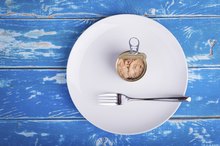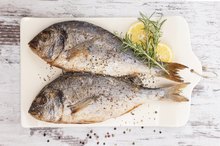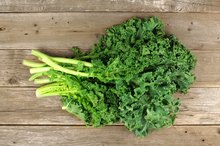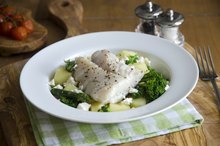What does fact checked mean?
At Healthfully, we strive to deliver objective content that is accurate and up-to-date. Our team periodically reviews articles in order to ensure content quality. The sources cited below consist of evidence from peer-reviewed journals, prominent medical organizations, academic associations, and government data.
- American Heart Association; Fish and Omega-3 Fatty Acids; 2010
- Harvard School of Public Health; Fats and Cholesterol: Out with the Bad, in with the Good; 2010
The information contained on this site is for informational purposes only, and should not be used as a substitute for the advice of a professional health care provider. Please check with the appropriate physician regarding health questions and concerns. Although we strive to deliver accurate and up-to-date information, no guarantee to that effect is made.
What Are the Health Benefits of Lox?
Lox, also called smoked salmon, can be eaten as an appetizer or entree for any meal. Salmon is among the healthiest finfish to eat because of its nutritional content and low rate of contaminants. A joint bulletin between the Environmental Protection Agency and Food and Drug Administration states that salmon is low in mercury and can be part of a healthy diet 1. Consult your doctor about your diet and the health benefits of lox.
Omega-3 Fatty Acids
Salmon, particularly wild salmon, is among foods with the highest concentrations of omega-3 fatty acids. Omega-3 fatty acids, such as eicosapentaenoic acid and docosahexaenoic acid, are healthy fats that may lower your risk of cardiovascular disease. The American Heart Association recommends that you eat at least two 3.5 oz 3. servings of fatty fish, such as salmon, per week to improve your heart health and reduce your risk of coronary artery disease and abnormal heartbeats associated with sudden death, slow the growth rate of atherosclerotic plaque and lower your blood pressure.
- Salmon, particularly wild salmon, is among foods with the highest concentrations of omega-3 fatty acids.
- servings of fatty fish, such as salmon, per week to improve your heart health and reduce your risk of coronary artery disease and abnormal heartbeats associated with sudden death, slow the growth rate of atherosclerotic plaque and lower your blood pressure.
Lean Protein
Nutritional Value of Canned Albacore Tuna
Learn More
Fish is a rich and healthy source of protein. Proteins are essential nutrients that contain amino acids. Your body needs proteins for cell structure, enzymes and regulation of cellular metabolic processes. Unlike red meat, poultry and dairy, foods that contain high amounts of saturated fat, salmon is a lean protein not high in saturated fat. Reducing your intake of saturated fat can lower your risk of heart disease. Saturated fat increases blood cholesterol and buildup of plaque inside your arteries, leading to the development of coronary heart disease.
- Fish is a rich and healthy source of protein.
- Unlike red meat, poultry and dairy, foods that contain high amounts of saturated fat, salmon is a lean protein not high in saturated fat.
Vitamins
Lox is a source of certain vitamins, particularly niacin and vitamin B-12. Niacin, also called vitamin B-3, can increase your HDL cholesterol, the good cholesterol. Vitamin B-12 is vital for production of DNA and red blood cells that transport oxygen from your lungs to your cells. Vitamin B-12 is found exclusively in animal foods and is frequently deficient among vegetarians and older people with malabsorption problems.
- Lox is a source of certain vitamins, particularly niacin and vitamin B-12.
- Niacin, also called vitamin B-3, can increase your HDL cholesterol, the good cholesterol.
Minerals
Nutritional Value of Bluegills
Learn More
Lox is also a source of certain minerals, particularly sodium, potassium and selenium. However, excess sodium may increase your risk of high blood pressure and stroke. Potassium is an electrolyte, a substance that conducts electricity in your body and plays a vital role in healthy heart function and skeletal and smooth muscle contraction, particularly to support normal digestive and muscular function. Selenium is a trace element and antioxidant that you need to support certain enzymes called selenoproteins and to protect cells from harmful chemicals and toxins.
- Lox is also a source of certain minerals, particularly sodium, potassium and selenium.
- Selenium is a trace element and antioxidant that you need to support certain enzymes called selenoproteins and to protect cells from harmful chemicals and toxins.
Related Articles
References
- United States Environmental Protection Agency; Consumption Advice: Joint Federal Advisory for Mercury in Fish; 2004
- University of Maryland Medical Center; Omega-3 Fatty Acids; 2010
- American Heart Association; Fish and Omega-3 Fatty Acids; 2010
- United States Department of Agriculture; National Nutrient Database for Standard Reference; 2010
- Fish, salmon, Atlantic, wild, raw. FoodData Central. U.S. Department of Agriculture. Published April 1, 2019.
- Fish faceoff: Wild salmon vs. farmed salmon. Cleveland Clinic. Updated 2014.
- Graff IE, Øyen J, Kjellevold M, et al. Reduced bone resorption by intake of dietary vitamin D and K from tailor-made Atlantic salmon: A randomized intervention trial. Oncotarget. 2016;7(43):69200-69215. doi:10.18632/oncotarget.10171
- American Heart Association. Eating Fish for Heart Health. Updated March 27, 2017.
- Collins K. The best winter foods for kids. Academy of Nutrition and Dietetics. Updated 2018.
- Fish: Friend or foe?. Harvard T.H. Chan School of Public Health. Updated 2020.
- Thomas J, Thomas CJ, et al. Omega-3 fatty acids in early prevention of inflammatory neurodegenerative disease: A focus on Alzheimer's disease. Biomed Res Int. 2015;2015:172801. doi:10.1155/2015/172801
- Galasso C, Orefice I, Pellone P, et al. On the neuroprotective role of astaxanthin: New perspectives?. Mar Drugs. 2018;16(8). doi:10.3390/md16080247
- Fish allergy. American College of Allergy, Asthma & Immunology. Updated 2019.
- Crinnion WJ. The role of persistent organic pollutants in the worldwide epidemic of type 2 diabetes mellitus and the possible connection to Farmed Atlantic Salmon (Salmo salar). Altern Med Rev. 2011;16(4):301-313.
- Bergkvist C, Kippler M, Larsson SC, et al. Dietary exposure to polychlorinated biphenyls is associated with increased risk of stroke in women. J Intern Med. 2014;276(3):248-259. doi:10.1111/joim.12194
- Jeffery A. Foran, David H. Good, David O. Carpenter, M. Coreen Hamilton, Barbara A. Knuth, Steven J. Schwager, Quantitative analysis of the benefits and risks of consuming farmed and wild Salmon, The Journal of Nutrition, Volume 135, Issue 11, November 2005, Pages 2639–2643, doi: 10.1093/jn/135.11.2639
- Salmon recommendations. Monterey Bay Aquarium Seafood Watch.
- Selecting and storing fresh and frozen seafood safely. U.S. Food and Drug Administration.
Resources
Writer Bio
Jeffrey Traister is a writer and filmmaker. For more than 25 years, he has covered nutrition and medicine for health-care companies and publishers, also producing digital video for websites, DVDs and commercials. Trained in digital filmmaking at The New School, Traister also holds a Master of Science in human nutrition and medicine from the Columbia University College of Physicians and Surgeons.









